VOL.1 S T U D I O S BLOCKCHAIN BTECH 3RD YEAR UNIT 1 TO UNIT 5 35 PAGES
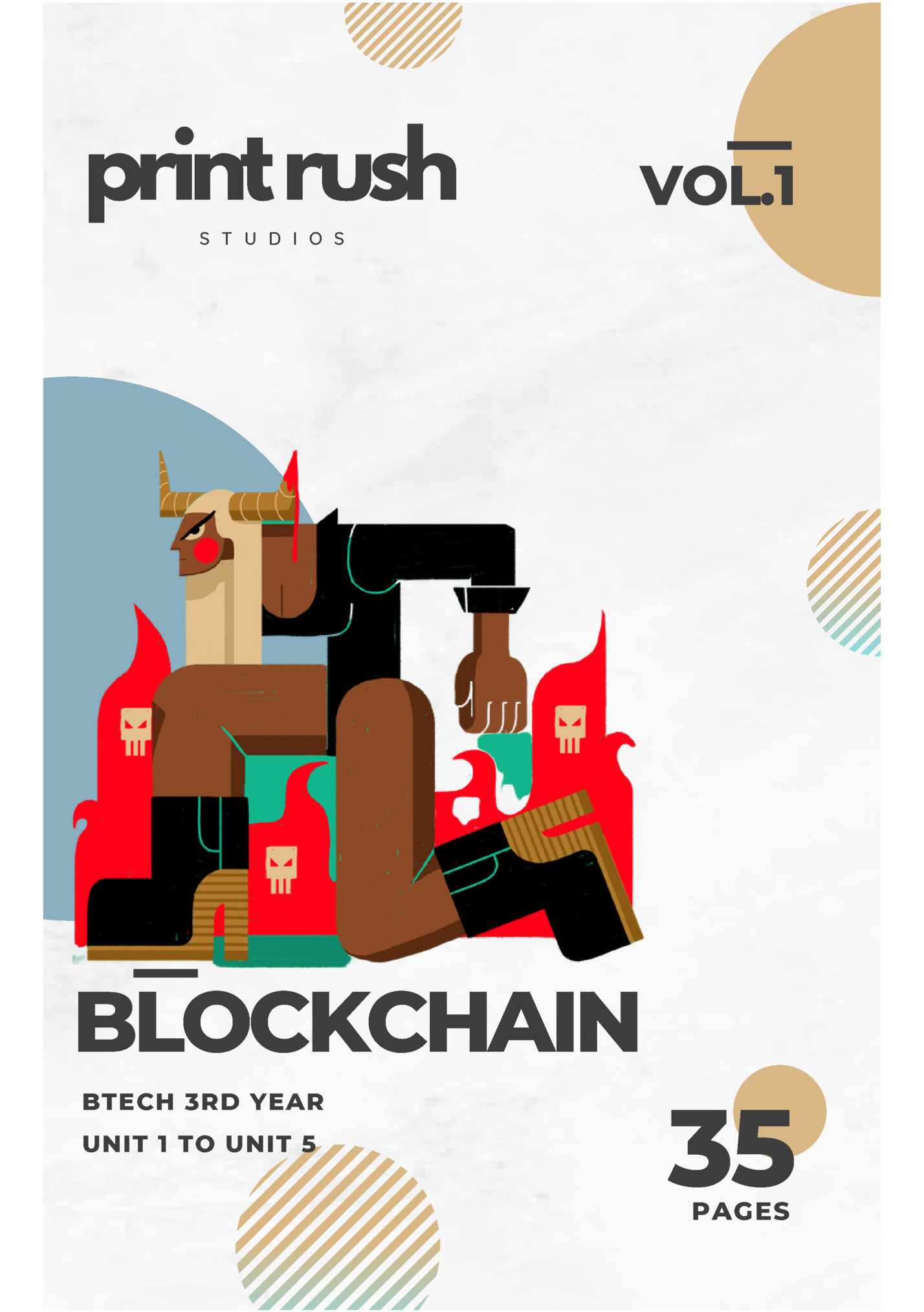
Blockchain/Unit-1 Unit 1 Blockchain- A transparent, public chain linking all transactions. It is a decentralised , distributed shared database which is permanent and immutable. The identity of people are kept anonymous over here. It consists of blocks linked to each other. A block consists of a header, and details of the transaction. Cryptocurrency- a type of currency which is decentralised i.e. not controlled by any government. Traditional currency Cryptocurrency Centralised Decentralised Processed through financial institution Processed directly through sender and receiver Less secure More secure Stored in banks Stored in digital wallets Have fixed value Doesn’t have fixed value Regulated Unregulated Less frauds More frauds Less anonymity More anonymity Example: coins and paper currency Example: bitcoin ● ● ● ● ● Block: A group of Bitcoin transactions verified by miners, who are rewarded with newly created bitcoin. Transaction: Computer directives like "payer X sends Y Bitcoin to receiver Z." Mining: Individuals or groups perform intensive computer calculations to create blocks. Block Hash: Records kept during mining to maintain a consistent, complete, and unalterable blockchain. Blockchain Address: A pseudonymous sequence of characters for sending and receiving Bitcoin, protecting personal information. 1

● ● ● ● ● ● Blockchain/Unit-1 Wallet: Digital credentials collection for exchanging and transacting Bitcoin. Full Clients: Wallets with a complete copy of the entire blockchain, considered safe storage. Lightweight Clients: Wallets with a limited blockchain version, suitable for portability but requiring trust in intermediaries. Keys: Credentials stored in the wallet, involving public and private keys for transaction security. Public Key: Technology for encrypting and decrypting transactions, ensuring blockchain continuity. Private Key: Passcode used to make transactions unique and secure, known only to the transacting party. eCash (Electronic Cash): e-Cash is a digital currency utilising blockchain technology, specifically digital signatures, within a Peer-to-Peer network. Here, transactions are recorded in digital databases, providing an alternative payment system without physical currency. Features: ● Decentralised, Transparency, Transactions are irreversible. ● Introduced by David Lee Chaum in 1983, establishing Digicash in 1998. ● eCash became available through banks like Credit Suisse, Deutsche Bank, Bank Austria, etc. The company went bankrupt in 1998, sold to eCash Technologies, which also went bankrupt in 2000 and was later acquired by Blucora in 2002. ● Examples of eCash: Cryptocurrencies, Central Bank Digital Currencies (CBDCs) (currency authorised by legal parties) and stablecoins (coins with stable values tied to a specific country's currency rate). On basis of Hard digital currency Soft digital currency Reversibility Transactions cannot be reversed Transactions can be reversed Type It is similar to hard copy cash payment. It is totally opposite of it Security More secure and less friendly Less secure and more friendly Supply Fixed supply Variable supply Example Example: bitcoin Example: tether Advantages of Digital Money: ● Flexibility: Enables easy global transactions. 2
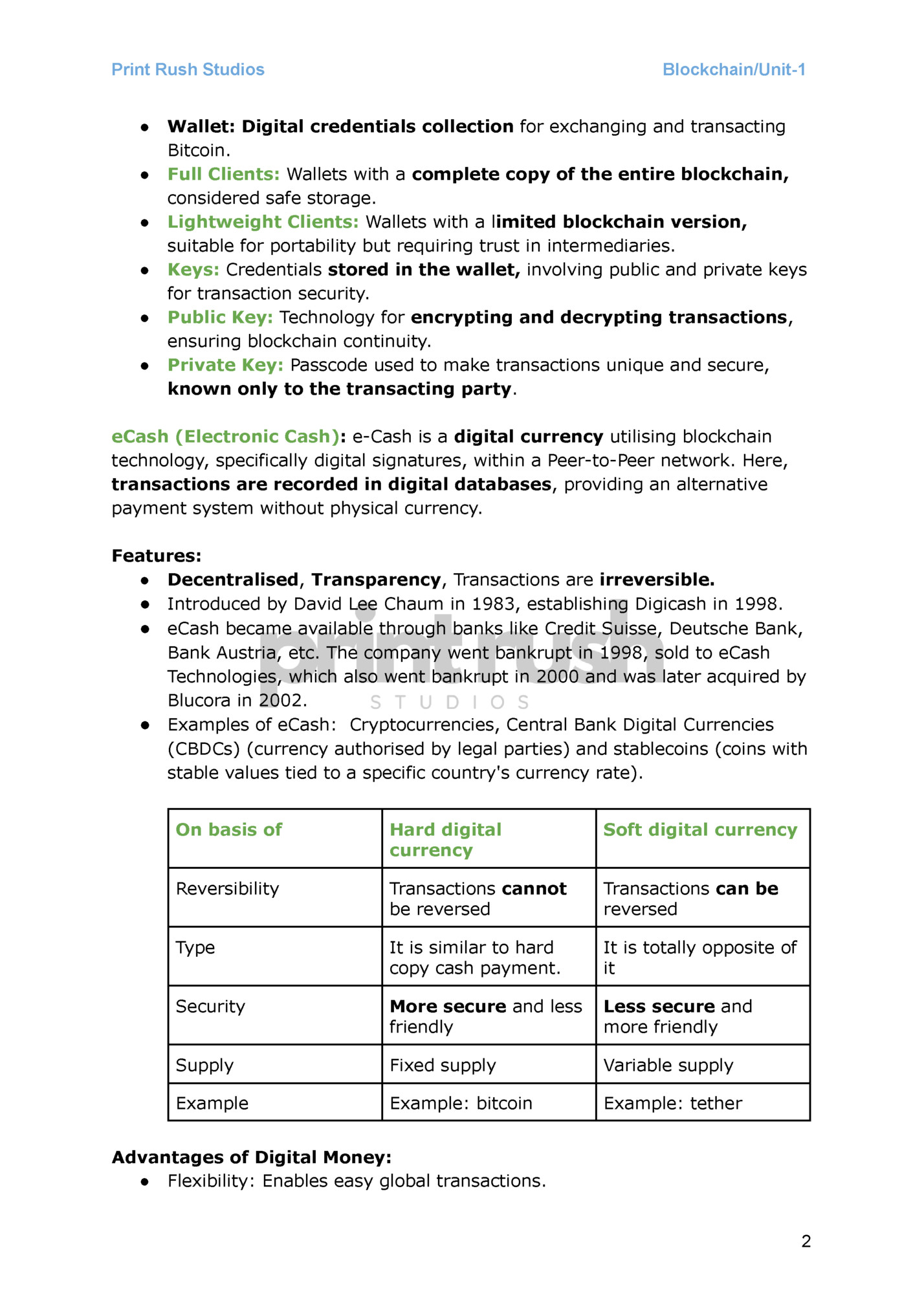
Blockchain/Unit-1 ● Security: Utilises a secure peer-to-peer network with encryption. ● Time Efficiency: Allows quick one-click payments. ● No Physical Copies Risks of Digital Money: ● Cyber Attacks: Higher vulnerability to cyber threats like phishing. ● Infrastructure Requirements: Demands substantial space and hardware for ledger data storage. ● Network Issues: Minor problems can lead to transaction failures Double spending: [End Sem 2019- 3M] Double-spending is the risk of using the same digital currency more than once, typically through altering transaction information within a blockchain. Each block in the blockchain contains encrypted data, including a timestamp and transaction details. Miners verify this information through proof-of-work consensus. To double-spend, someone must mine a secret block faster than the real blockchain, introduce it to the network, and successfully reclaim and reuse the cryptocurrency. For example, a user might pay Merchant 'A' digitally and then use the same cryptocurrency to pay Merchant 'B' before transactions are confirmed, creating an illusion of credited funds and illustrating a case of double spending. Types of Double Spending Attacks: ● ● ● ● Finney Attack: Merchant accepts an unauthorized transaction, leading to the loss of money for the merchant twice. Race Attack: A 'race' between two transactions where the attacker sends the same money to two different merchants, rendering both transactions invalid. 51% Attack: Occurs when a hacker controls over 51% of a blockchain's mining power, giving them significant control. Unconfirmed transaction attacks are common. Caution is advised against accepting such transactions to prevent attempted double-spending attacks. How Bitcoin Handles Double Spending: Bitcoin employs security measures to mitigate double spending, including: ● Validation: Transactions need validation from a maximum number of nodes before being added to the blockchain. ● Timestamp: Confirmed transactions are timestamped, making them irreversible. ● Block Confirmations: Merchants require a minimum of 6 confirmations to ensure no double spending. ● Saving Copies: Each node keeps a copy of transactions, preventing network failure. 3
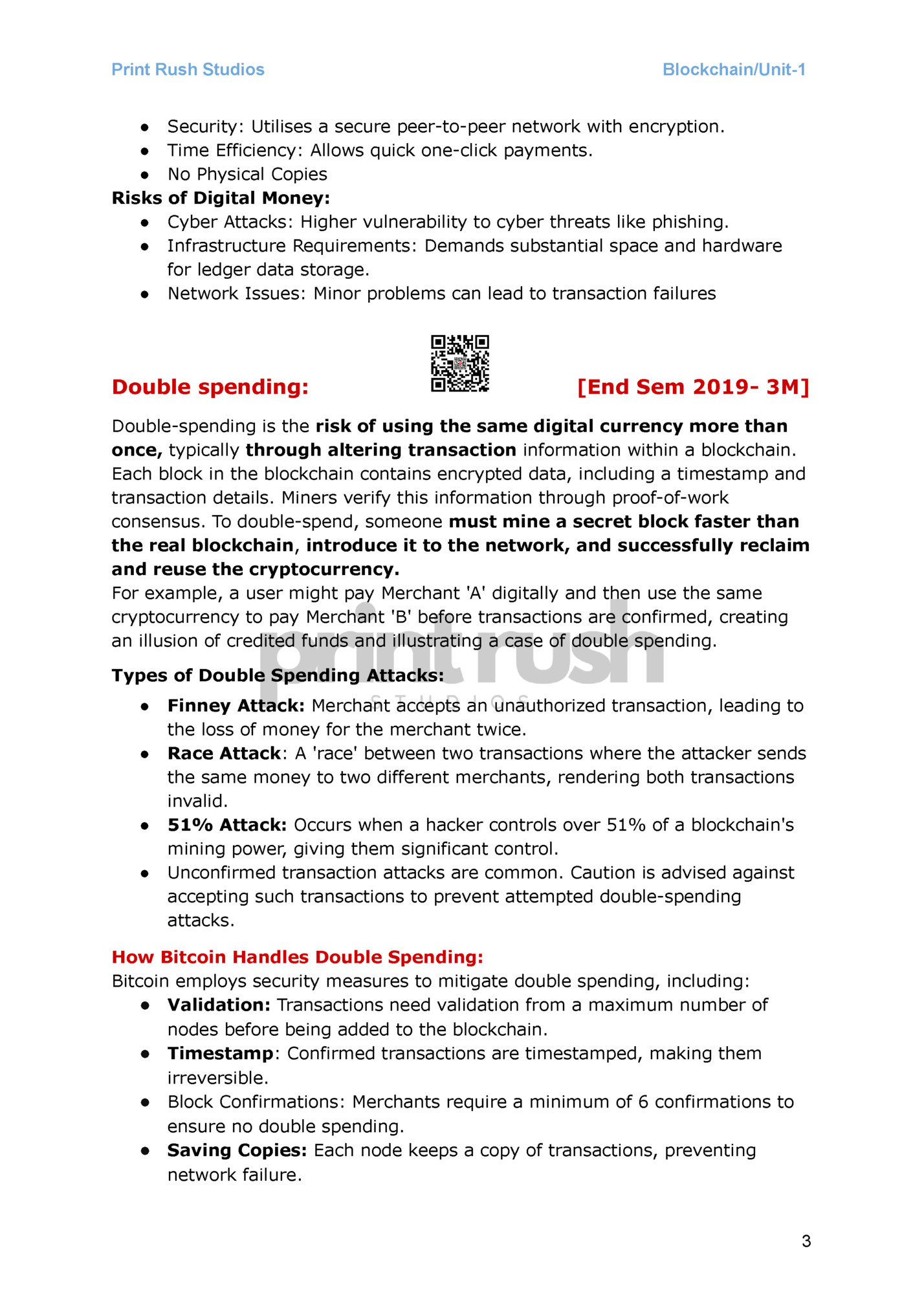
Blockchain/Unit-1 Users can combat double spending by: ● Waiting for Confirmations ● Securing Hardware ● Avoiding Phishing Disadvantages of Blockchain Concerning Double Spending: ● Control Issues: If hackers control 51% of computational power, they can manipulate transactions. ● Information Alteration: Hackers can alter transaction information using attacks. ● Lack of Authority: The absence of a central authority can pose challenges, but proper security measures can address these concerns. Preventing Double Spending: ● ● ● Centralised Approach: Involves a third party verifying transactions, but this has drawbacks such as dependence on a central authority. Decentralised Approach: Double spending is minimised by the blockchain, as the insertion of a secret block into the blockchain is unlikely to be accepted and verified by the network of miners. The primary method for a miner with poor intentions to insert an altered block involves convincing another user to accept a transaction using their secret block and cryptocurrency. However, the rapid pace of the blockchain makes the acceptance of a modified block tough. Even if accepted, the network would have already moved past the outdated information, leading to rejection. Bitcoin ProtocolThe Bitcoin protocol ensures secure and decentralized transaction creation and validation. Bitcoins are mined and widely exchangeable, with over 100,000 merchants accepting them. Ongoing debates focus on balancing protocol changes for faster transactions while maintaining stability for security. The protocol governs miners, transaction order consensus, and block size. Bitcoin transfers follow secure verification and confirmation processes. Bitcoin Transaction Mechanism: A Bitcoin transaction includes a unique ID (SHA256 double-hash), input (sender's bitcoin addresses), amount (quantity of bitcoins), and output (recipient's address, with provisions for change or transaction fees). Outputs from one transaction can be inputs for another, establishing a chain of ownership. Bitcoin Protocol Process: ● A new transaction is broadcast to all nodes. ● Nodes collect transactions into a block. ● Nodes validate transactions and solve Proof of Work for the block. ● The node finding the solution broadcasts the block. ● Nodes validate and accept the block. 4
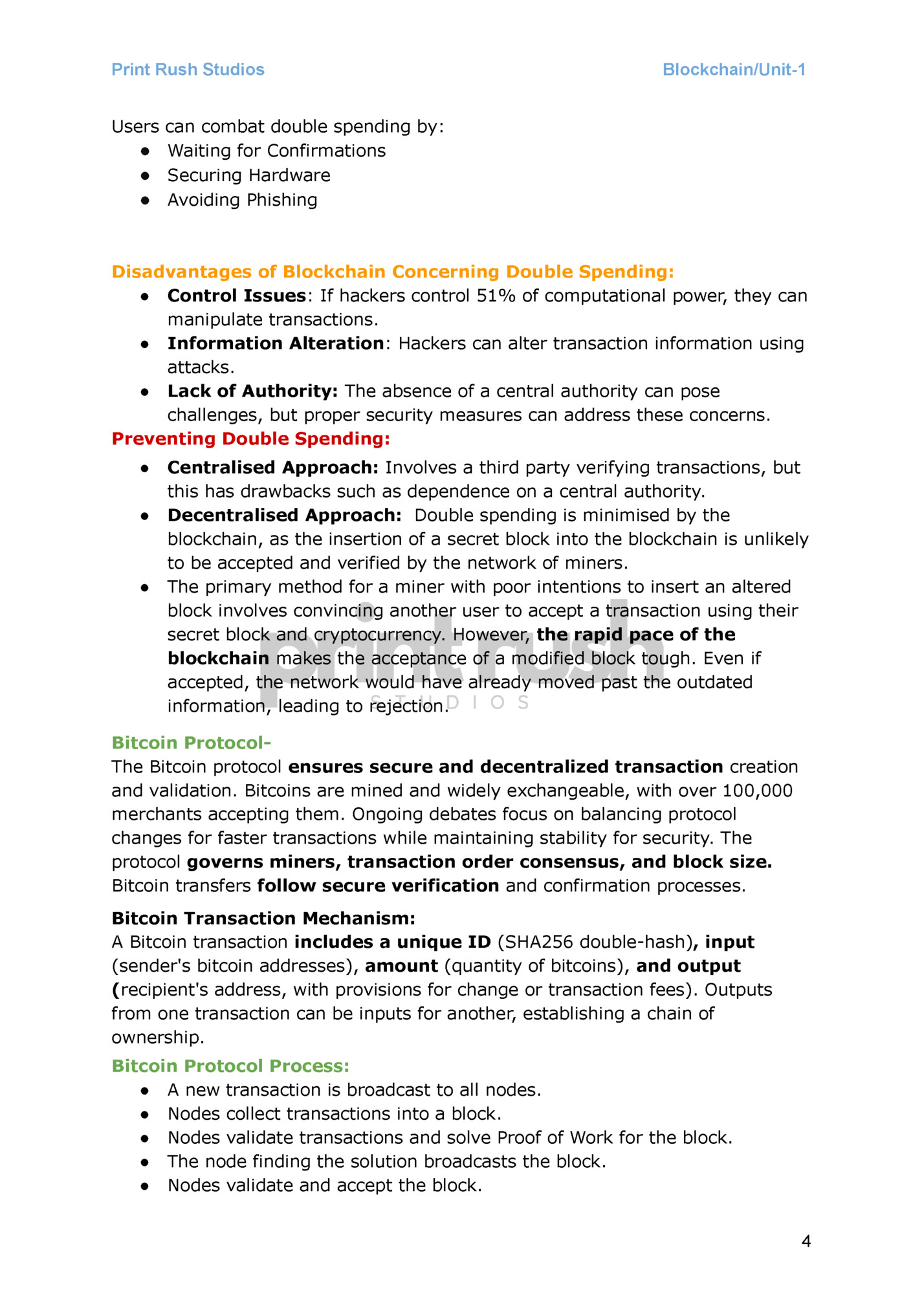
● Blockchain/Unit-1 Nodes initiate work on the next block, using the last accepted block's hash as a reference. Mining : This process ensures the secure creation, validation, and acceptance of Bitcoin transactions in the decentralised network. Bitcoin relies on a peer-to-peer network and a process called Bitcoin Mining to add transaction details to the Blockchain. Miners are given rewards for their computational efforts in securing transactions and making accurate decisions. How Bitcoin Mining Works: 1. Mining involves high computational power to solve complex algorithms and add transaction records to the Blockchain. 2. Miners discover new Bitcoins by solving these algorithms, and Bitcoin is designed to be mined approximately every 10 minutes. 3. Miners worldwide use their computational resources to process transactions and, in return, are rewarded with Bitcoin. 4. Incentives of Bitcoin Mining: small percentage of the total transaction value ➔ Block Rewards: given to miners for solving complex mathematical algorithms adding transaction records to the Blockchain. The Block Reward halves approximately every four years, impacting the total amount of Bitcoin rewarded to miners. Incentive Pools: Miners often form incentive pools to collaborate on creating blocks and share rewards equally among participants. Incentive pools help maintain Blockchain protocol integrity within a decentralised system. Challenges and Future Improvements: ● Blockchain miners face challenges as their incentives decrease with fewer transaction fees. Incentives are crucial for motivating miners and keeping the Blockchain secure. However, there are ongoing issues as miners try creative methods to maximize profits. It's important to continually improve how we incentivize miners to maintain a strong and reliable Blockchain system. Blockchain Wallets: [End Sem -2019 7M] A blockchain wallet manages cryptocurrencies like Bitcoin or Ethereum, facilitating easy fund exchanges. It ensures secure transactions with cryptographic signatures, accessible from various devices while maintaining user privacy. Examples include Electrum, Blockchain.info, and Jaxx, chosen based on security needs. 5
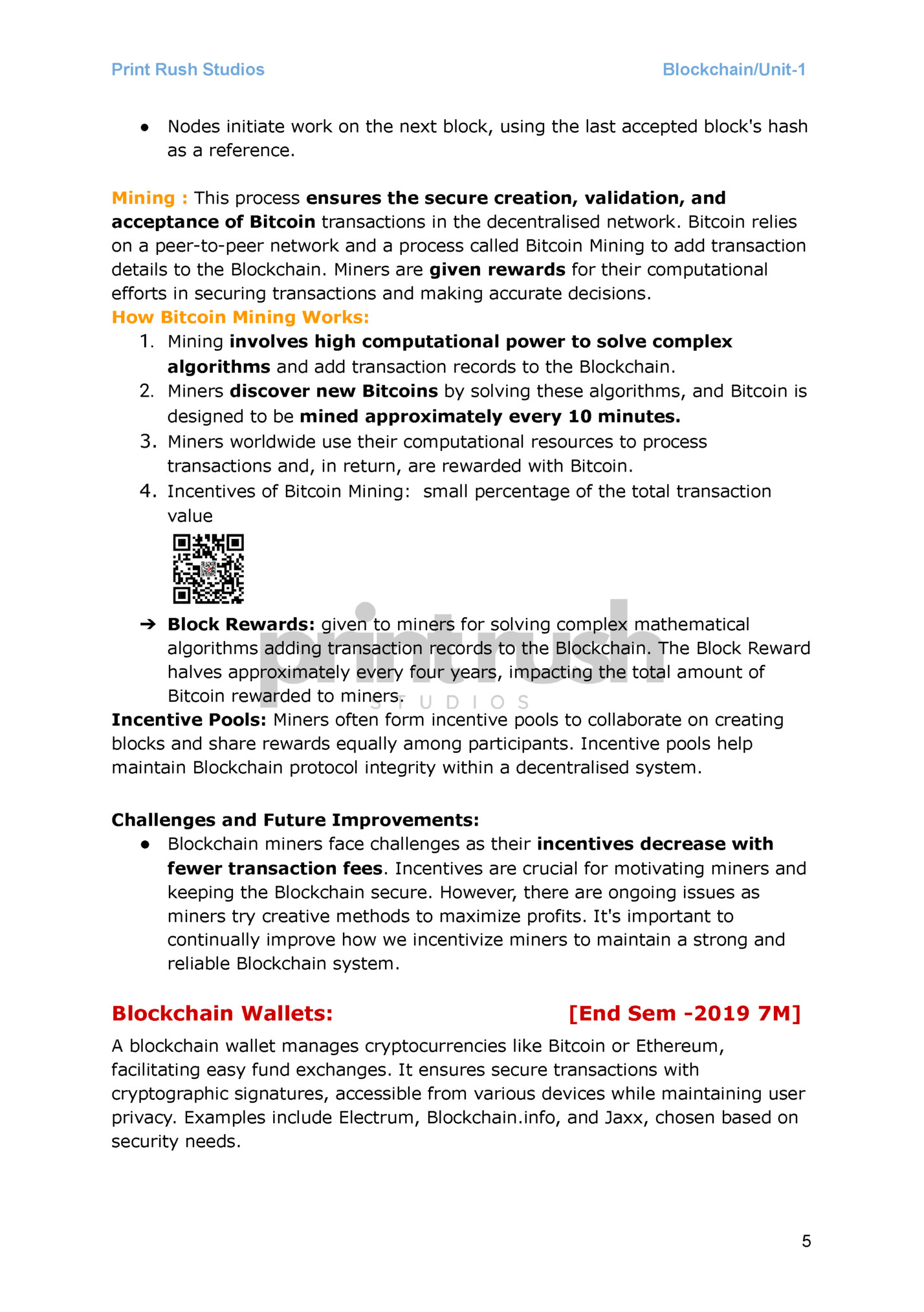
Blockchain/Unit-1 Why Use a Blockchain Wallet? Traditional banking has issues like slow transactions, central points of failure, and data vulnerabilities. Blockchain wallets address these problems, providing a secure and efficient way to transfer and exchange funds between parties. How do blockchain wallets work? Blockchain wallet consists of 2 types of keys. When creating a blockchain wallet, you receive a private key (like a password) and a public key (similar to an email address). The public key can be shared for receiving funds, while the private key, kept confidential, is used to spend funds. Just as knowing your email address doesn't give access to your account, sharing the public key doesn't compromise your wallet. The private key, however, must be safeguarded to prevent unauthorised access and potential loss of cryptocurrency deposits. Blockchain Wallet Features: 1. User-Friendly: Easy and intuitive for day-to-day transactions. 2. High Security: Emphasises the importance of securing your private key. 3. Instant Global Transactions: Facilitates quick, barrier-free transactions worldwide 4. Low Transaction Fees: Cost-effective fund transfers with lower fees. 5. Multi Currency Transactions: Enables seamless transactions across multiple cryptocurrencies, allowing easy currency conversions. Functional Hot wallet Cold wallet Storage location Online storage, needs internet Offline storage, needs hardware or paper Security Less secure More secure Future transactions convenience More convenient for frequent transactions Less convenient for frequent transactions Use Case Ideal for short term storage Ideal for long term storage Types Online wallets, mobile wallets Hardware wallets, paper wallets Risk Tolerance Higher risk due to online exposure Lower risk due to offline storage Complexity Easy to setup Complex to setup Speed Faster transactions Slower transactions 6

Blockchain/Unit-1 Updates Regular updates required Less frequent updates required Cost Free or lower cost Have upfront cost for hardware storage Example Coinbase , binance Trazor Types of wallets[End Sem 2019 -7m] 1. Software Wallets: ● Application downloaded on devices (desktop, mobile, or web-based). ● Examples: Breadwallet, Jaxx, Copay. ● More prone to attacks ● Further categorized as desktop wallets, online wallets, and mobile wallets. ○ Desktop Wallets: ■ Cold wallets with private keys stored on the desktop. Can be used offline, with the desktop serving as a backup server. ■ Cost-efficient; example: Electrum. ○ Online Wallets: ■ Hot wallets accessible via the internet. ■ Private keys stored online and managed by a third party. ■ Example: GreenAddress. ○ Mobile Wallets: ■ Designed for mobile phone use. ■ User-friendly interface; example: Mycelium. 2. Hardware Wallets: ● Cold storage devices (e.g., USB) storing private keys. ● Connected to a computer when making transactions. ● Less prone to attacks; examples: Ledger, Trezor, KeepKey. 3. Paper Wallets: ● Offline method for storing cryptocurrencies. ● Printed paper with private and public keys, accessed via QR code. ● Widely used for storing large amounts. ● Examples: Bitcoin Paper Wallet, MyEtherWallet. Legal Aspects of cryptocurrency[End sem 2019 -7M] 1. Contractual Issues: Smart contracts on blockchain lack clarity in traditional contract law. U.S. federal law doesn't clearly define the legal validity of smart contracts, leading to potential legal disputes. 2. Jurisdictional Issues: Blockchain's decentralised nature makes it challenging to determine jurisdiction. Nodes in different places may face conflicting legal rules, complicating law enforcement. 7

Blockchain/Unit-1 3. Data Theft and Financial Fraud: Cryptocurrency anonymity can attract users for illegal activities. Security flaws pose legal concerns, and existing laws may not cover cryptocurrency-related fraud well. 4. Privacy Concerns: Privacy features of cryptocurrencies are at risk from blockchain analytic tools. The U.S. lacks a clear federal data protection framework for this decentralized technology. 5. Money Laundering: Cryptocurrencies enable anonymity, facilitating money laundering. Illicit transactions occur on dark-market sites, and some trading methods may bypass anti-money laundering rules. 6. Tax Implications: Cryptocurrencies are treated as property for U.S. tax purposes. Reporting transactions in U.S. dollars and determining fair market value can be complex. Capital gains taxes apply to cryptocurrency profits; rules for foreign exchanges are unclear. 7. Intellectual Property (IP): IP concerns arise in industries using cryptocurrencies. Controlling IP distribution and enforcing agreements via smart contracts are challenges. Ownership uncertainties exist for blockchain technologies in IP-intensive sectors. 8. Legal and Regulatory Concerns for Investors: Cryptocurrencies are legal in many developed countries, but legal issues remain. Lack of centralized backing raises questions about legal recourse for investors.Ongoing legal and regulatory changes may impact the cryptocurrency landscape. Cryptocurrency Exchange Architecture: Cryptocurrency exchange architecture refers to the structure and components that make up a platform for trading digital assets. Blockchain technology facilitates global cryptocurrency trading, with the market projected to reach USD 1125.8 million by 2028, reflecting its growing popularity. Decentralized blockchain ensures consensus and validation, operating as a secure network of interconnected computers, distinct from centralized systems. 8
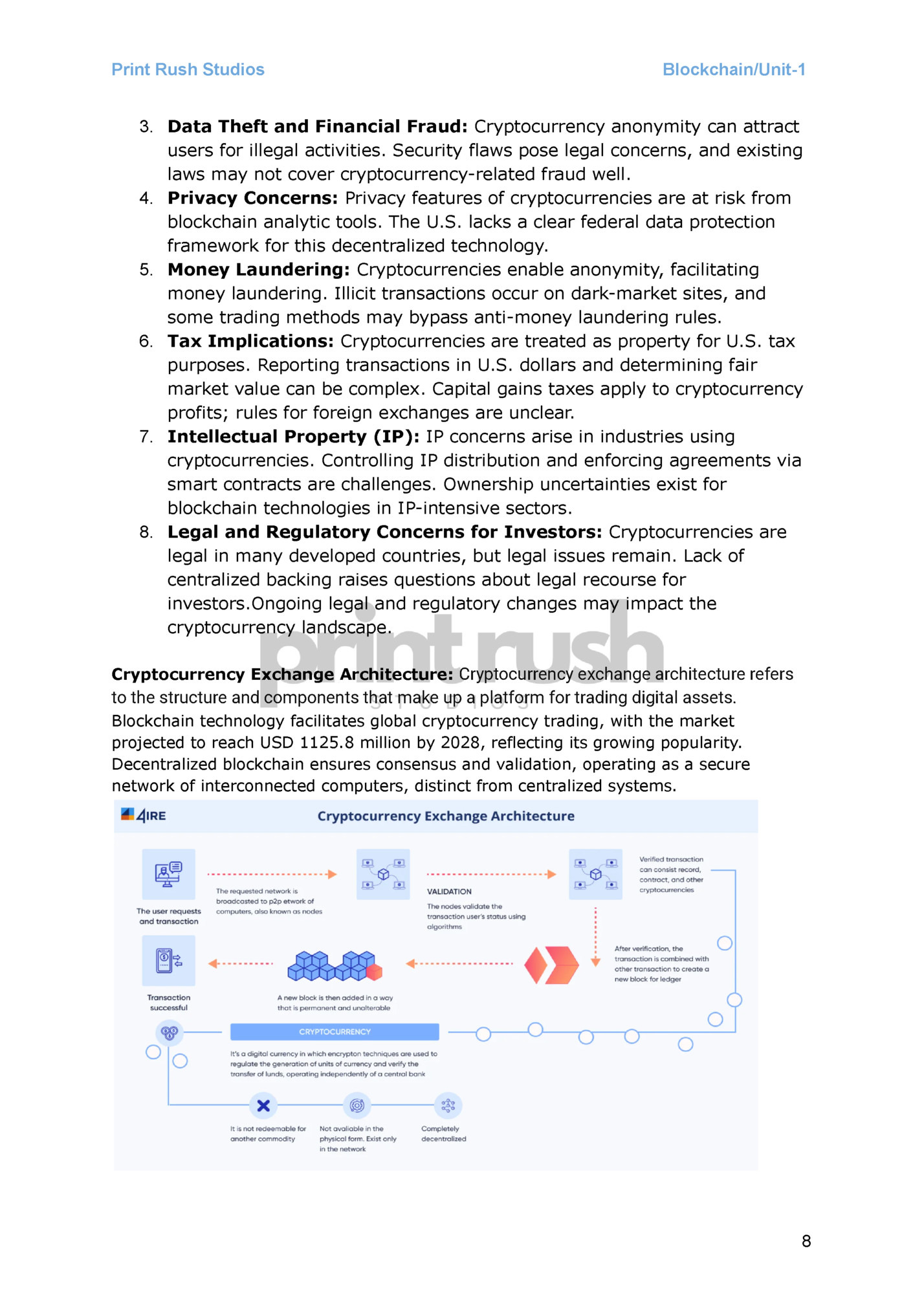
Fleepit Digital © 2021